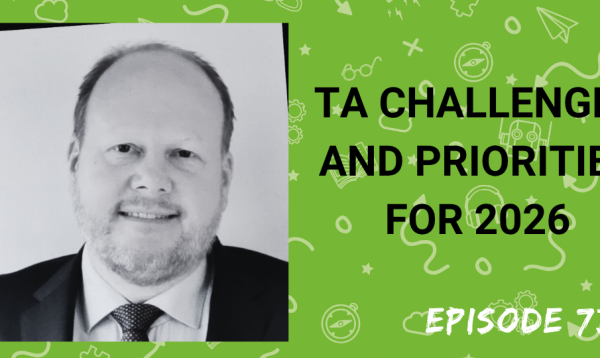One of the topics I get asked to cover frequently is the growth of the corporate executive recruiting function. So with that in mind, I’ve partnered with ESIX, The Executive Search Information Exchange, to bring you a series of three interviews exploring the key trends and issues in corporate executive recruiting.
In the first interview of the series, my guest is Simon Mullins, Chief Facilitator of ESIX. ESIX run a yearly membership, and in our discussion, Simon gives us an exclusive preview of the results of this year survey, highlighting the key trends the pandemic is driving in corporate executive recruiting.
In the interview, we discuss:
▪ Background to ESIX
▪ The growth of the corporate executive recruiting function
▪ Pandemic driven trends
▪ Reducing time to hire
▪ The executive talent market
▪ Interview and assessement
▪ Location flexibility
▪ Diversity challenges
▪ How onboarding is changing
▪ Simon’s hopes for the next 18 months
Listen to this podcast on Apple Podcasts.
Transcript:
Matt Alder [00:00:00]:
Support for this podcast comes from E6. For 25 years, E6 has been the preeminent peer networking and independent information source for corporate executive recruiting leaders worldwide. Featuring members from around 100 of the leading employers in the world, it is the one stop shop for trusted networking with peers, for benchmarking and for team development. Find out more about membership@www.e6.org. That’s WW and E6 is spelled E S I X. Or buy their book Leadership Recruiting on Amazon.
Matt Alder [00:00:53]:
Hi everyone, this is Matt Alder. Welcome to episode 363 of the Recruiting Future podcast. One of the topics I get asked about frequently is the growth of the corporate executive recruiting function. So with that in mind, I’ve partnered with e6, the executive search information Exchange to bring you a series of three interviews exploring the key trends and issues in corporate executive recruiting. In the first interview of the series, my guest is Simon Mullins, Chief Facilitator of E6E6 run a yearly membership survey. And in our discussion, Simon gives us an exclusive preview of the results of this year’s survey highlighting the key trends the pandemic is driving in corporate executive recruiting. Hi Simon, and welcome to the podcast.
Simon Mullins [00:01:48]:
Well, thank you very much. It’s a pleasure to be here, an.
Matt Alder [00:01:50]:
Absolute pleasure to have you on the show. Could you just introduce yourself and tell us what you do?
Simon Mullins [00:01:55]:
Certainly. So my name is Simon Mullins. I live near seattle in the US but I’m originally from the UK. I run an organization called E6 which stands for the Executive Search Information Exchange. And I’ve been running this for almost seven years now, which is amazing. Which is. And it’s fun, it’s fantastic. It’s effectively a networking group of organizations, corporate organizations and actually some, a couple of non corporates as well. But corporate organizations who we all get together and work and talk, I should say work on and talk about the corporate executive recruiting function. So we provide networking events, we provide benchmarking data, various other tools including search consultant selection tool, and then we have training classes too and we’ve written a book.
Matt Alder [00:02:41]:
Fantastic stuff. So just tell us a little bit more about the organization, specifically in terms of the type of companies that are members.
Simon Mullins [00:02:50]:
Absolutely, yeah. And it’s been around for 25 years. It was actually founded by a chap called David Lord, I should give him credit for that. But as I say, took over seven years ago. So yeah, it’s these organizations, again, all corporates except we actually have the US Air Force and a couple of charities with us as well. But they’re organizations and brands that you’d recognize. Large chunk of them are in the US but actually quite a few are also based in Europe and other parts of the world, Asia Pacific as well. And they’re everything from massive banks. I mean I could mention names, but that would be kind of unfair. But massive, massive financial services organizations, but also to relatively small technology, not necessarily startups, but mid sized organizations, the kind of companies that you might drive around from place to place thanks to their service. But also financial services, Fintech I suppose, large healthcare soda companies, very large technology, chip and semiconductor and services and software and so on and so forth, but very much large organizations. I think we have a significant chunk of the Fortune 200 as members, but we also have, as I say, a large number of other organizations which are kind of up and coming, but brands that you mostly recognize.
Matt Alder [00:04:07]:
So we, we obviously on this podcast we talk a lot about how recruiting and talent acquisition are changing. Podcast has been running for, for over six years now. So we’ve been talking about a lot of changes over a long period of time rather than just the, the craziness of the last last 18 months. But, but one of the things that we, we haven’t really discuss that much is how executive search is changing. In your sort of experiences of running the organization, what are the biggest changes that you’ve seen? I suppose kind of, you know, leading up to the sort of the pandemic time that we’re in now.
Simon Mullins [00:04:47]:
Yeah, it’s been very interesting. So actually my history is, by the way, just for the record is I was before I was running this, I was running corporate exec recruiting for Microsoft and I was there for 10 years and most of the time running executive recruiting there. And this adds context. Matt, sorry, but. And then before that I was seven years at a very large executive search firm called Korn Ferry, and then before that a number of years at smaller organizations, both search and also contract recruiting. So I’ve been lucky enough to have seen, I don’t like to say both sides of the desk because I don’t want to make it kind of a competitive situation. But I’ve been lucky enough to see both sides of the equation, I suppose, executive recruiting, corporate side and also executive recruiting as a search firm. And in general, what’s funny is that it hasn’t changed that much. The industry in general and then of course our side of it, the corporate side of it has changed quite a bit, but at the overarching level doesn’t seem to change. So, you know, executive search industry, some estimates have it around 16 billion US in on its own as a revenues and a growing, seems to grow every year, which is amazing considering there’s also at the same time a growth in the idea of corporate executive recruiting functions. And those are not meant to be incompatible or they’re not meant to be sort of one against the other. So corporate executive recruiting functions do not not use search firms. In fact, probably 90% of them still use search firms. It’s more that they just use them in a better way of managing them and also managing the cost. But often they’ll also do a lot of direct hiring and only use search firms in certain places when it’s really important and necessary to do so. So all that being said, what we haven’t seen is some mega change towards large corporates using in house teams. What we have seen is kind of a growth in a more professional, more sophisticated, more strategic management of using search firms and also the search process in general. And you know, we’ve seen in a kind of a broader sense, we’ve seen assessment tools being used more and more. We’ve seen a lot more folks getting involved, not a lot more, but a number of folks getting more involved in board hiring at their corporations. Now we’ve seen a lot more involvement with the internal succession and external succession being more coordinated and connected. So it’s been, it’s exciting, but it hasn’t been a super fast radical change towards in house executive recruiting by any means. It’s been a very slow growth. But that has been, it’s been impressive and certainly made an impact.
Matt Alder [00:07:25]:
So Obviously the last 18 months has been very disruptive and driven lots of change in players in every industry and everything that we do. In everything that we do really. I know that you run an annual survey and I believe the survey is sort of still running at the moment, but you’ve got a sense of some of the results coming through and certainly some of the trends. What have you been seeing in the last 18 months in terms of changes to the landscape?
Simon Mullins [00:07:49]:
Yeah, exactly. No, it’s very interesting. So as you said, we’re right in the middle of our current survey but we have most of the data is probably in. So I can give some indicators and don’t tell the members this but because none of them know about this yet. But anyway, so we can give them some little bit of an indication here and what you do expect as we hear across all, you know, in fact many of your shows, which by the way, I should mention I love and I listen to avidly because I learned so much from them. So thank you. But in many of your folks have been saying, and your interviewees have been saying, you know, time is time to close in recruiting process, it seems to have got a lot faster thanks to, mostly thanks to interviewing via video and so on and so forth. And of course that’s the same in executive recruiting. So that’s one of the indicators we’re seeing is that where traditionally it’s a three or four month process in executive recruiting, we are seeing something like, and we can’t tell you exactly because we’re still to say collecting data, but something like a 15 or 16% reduction in time to close, or should say time to hire, which is, you know, okay, it’s a simple and basic measure. There are better measures of quality. But as a, as an indicator of how the entire process has been changed by video interviewing in particular, and probably also by remote hiring in general, remote start, remote location, etc. Then you know, that’s a standard, that’s a standing indicator, which is very helpful. And in fact we ask that kind of classic quantitative data, but actually also asked this year what is likely to change, what is likely to not change post Covid. And again, early indicators. But what we’re hearing is that, and again not surprising, but is that in general, especially in the executive recruiting space, it is very unlikely that we’re going to go back to in most cases and not everybody, but in most cases it’s unlikely that we’re going to go back to all interviews being in person. Chances are, and again, remembering this is both qualitative feedback and also early indicators and as yet not fully properly analyzed. But my belief is that we’re going to, most people are going to, most organizations are going to do maybe the final interview, final round of interviews in person only, which is again not surprising probably to most people, but that won’t change back. And also chances are in fact, so again not surprising, but chances are even at the executive level there’s been a lot more flexibility around location of the literally where they’re going to be living, location of where they’re going to be working. So they may not have to come into the headquarters office, but maybe they’ll go to some other place. Whereas traditionally in most organizations, of course, the executives have always come to headquarters, but not necessarily anymore. And also even if they are expected to physically move at some point, the other indicator we’re getting is that in some places some organizations will be giving like a two year kind of allowance time I suppose so they won’t actually have to relocate for a couple of years if they are expected to relocate. So it’s and, and then of course there’s the downstream which we don’t yet know more about. But okay, what does that mean? Travel and expenses, adjustment to compensation, all that again is coming up in across the recruiting function. Not necessarily just exact, but it’s, you know, it’s all going in the same direction and it’s very interesting I have to say. And even with all this I’m going to go on if you don’t mind but even with all this, those indicators I mentioned earlier about more strategic use of corporate exec recruiting functions and so on have continued. I frankly would have thought that last 15, 18 months would have perhaps held things back. And of course we did get a pause I suppose for a while. But what we’re hearing now from our members is that everybody is crazy busy, super intensely busy the corporate side. And in fact so are the search firms. In fact I just heard anecdotally that the search firms have had their biggest, sorry the very large search firms, there’s many, many large and many, many medium and small size search firms. But the very large search firms apparently are having their biggest revenue year ever this year. Not necessarily since COVID or pre covered or around that time, but apparently ever that’s what we’re told now I don’t know if it’s true but you know, so it’s, it’s a. What’s weird about this is everything’s weird and changed and different and if anybody’s ever studied economics, you might as well just throw out a textbook because I don’t know what’s going on anymore. But anyways, all that being said, all that we’re seeing is that, well, everything that we’re seeing is that still growing, still highly strategic, still more activities around, you know, getting as I say, getting involved in succession more direct hiring teams. But yet the way we’re going to move forward in terms of things tactically like interviews and location, of course I don’t think we’ll ever go back in most cases.
Matt Alder [00:12:47]:
You mentioned that the in house direct teams had been sort of gradually evolving and growing over the years. Is there what does this survey indicate in terms of that trend? Is that something that’s continuing?
Simon Mullins [00:13:00]:
Yeah, it is. And this is, it’s funny because some people say wow, isn’t this kind of a taken over? Isn’t it some tsunami of executive of corporate exec recruiting functions? No, it never has been. But we’ve seen a constant growth. As I mentioned, we’ve been doing a survey like this or the group has been doing a survey like this around 20 years. We’ve taken the last three or four years worth of data and so 2018 of our respondents and we’re not talking a huge number, I get that. And I also get that there are, there are somewhat different set. In other words, they’re usually large organizations, pretty sophisticated organizations and so on and so forth. So I get it’s not exactly an indicator of the entire marketplace. But of that set in 2018, 72% had some sort of a direct hiring in house executive search function of some kind. And that crept up to in 2020, I think it’s 79% from 7072 to 79%. And our indicators this year 2021 data is telling us that that’s 85%. So more and more organizations having some sort of in house team now again, caveat, caveat, et cetera. But it is an indicator across the board. And what’s fascinating again this might be kind of confirmation bias and I get that, is that we’re seeing more organizations who are not in the US And I don’t mean to be super US centric, I’m not originally from the US but it does seem that a large number of corporates that had an in house function started it in the US and it was a US kind of thing. Of course the UK a lot more organized organizations in the UK and Europe now have in house executive functions. And not just huge corporations either, some up and coming, I mean really solid names, brand, big brand names, but not necessarily, not necessarily massive organizations. And now we’re seeing Asia Pacific organizations in general also connecting back with us and saying hey, we’re interested in this kind of a thing. So that’s the other part of it is that is that not only is the actual function becoming more of a thing I suppose, but also more organizations in more parts of the world are starting to take on this idea and those organizations that already have a function are putting team members in various parts of the world. So now we have people who join our meetings in Moscow, in Eastern Europe, they’re of course in South Africa, in the Middle east, in Singapore, Hong Kong, Beijing, China, Beijing, Shanghai, sorry, Australia. So we’ve got people joining our meetings and of course the great thing is they can because they’re all virtual now or online. But this is also now a thing where team members are all over the world. And this is corporate executive recruiting. Remember, this is not, this is not high volume staffing, which you’d expect, but this is corporate executive recruiting, which is also a new trend, relatively new trend in the last few years as well.
Matt Alder [00:15:52]:
And sort of how far up the levels of the organization are these, these teams operating in terms of the sort of seniority of the people they’re recruiting?
Simon Mullins [00:16:01]:
Yeah, that’s, that’s funny. That was a question I used to ask in the, when we, when we had meetings in rooms, you might remember that in the old days, but when we had meetings in a room and I’d ask the room and I’d say, okay, what does executive recruiting mean to you? And you’d get, you know, if you had 20 people in the room, you’d have 20 different answers. However, we, and so that’s why we kept asking this question over time, because we kept trying to figure out, okay, what does it really mean? So in the majority of cases, we’re finding that executive recruiting means different things, of course, to different people. You can’t use titles because titles means nothing in some places and it means a huge thing in another place. But what we ended up discovering is something like 1 1/2 percent. So the top 1 1/2 to 2% of the organization, if you’re recruiting at that, if you take the organization of 100%, of course, and your top 2% employees, top 1 1/2% of your employees, and you’re working in that pool as clients and candidates, that’s roughly a gauge of what most of our members are working or that range of that, what they’re working in. And it’s, you know, minimum probably 350, 400,000 U.S. but of course, again, that depends on the industry, that depends on parts of the world and so on and so forth. And title is really not very helpful. But yeah, and more and more organizations are working in that space, but that’s by far the majority.
Matt Alder [00:17:19]:
I mean, again, this is obviously going to be very different in terms of industries and in terms of geographies. But one of the things that we’ve been talking a lot about on the podcast in the last few weeks, various sort of talent markets around the world and how difficult it is to recruit people. What’s the talent market like at this level? Are people willing to, to make moves? What’s, what’s sort of going on out there?
Simon Mullins [00:17:42]:
Yeah, well, there’s almost two parts to that question. So the talent market in itself and in fact the methodology That I think differentiates this function in particular is of course it’s not about applicants. And I know I’m stating obvious, but it’s not about applicants in most cases. It’s where we’re going out as a function and discovering. It’s again, nothing new here to anybody but going out and discovering talent pools and reaching out to them. Often cold. But now of course there are methodologies and ways of doing that, which it doesn’t have to be cold, but some cases it’s cold. And I don’t say cold calling anymore because it rarely do as we call anymore, unfortunately, but cold approach anyway. And then of course, reaching out and developing relationships and so on and so forth. And the reason I say there’s two answers or two parts to this answer is because it’s always been a challenge. And of course when you step into the area of underrepresented groups or diversity, it is even more of a challenge because of course, as we well know, there is a tiny proportion of, of senior leaders across the board who are non or who are underrepresented or non white males or whatever it might be is, it’s, it’s a tiny proportion, unfortunately, so it makes it even more of a challenge. And that’s been high on our members agenda for, actually for at least a decade. It’s probably been the highest priority for our members in general has been finding underrepresented executives or diverse executives anyway, so. But back to the actual question. So the, the two parts to this are that it’s always been difficult, it’s always been about relationships, it’s always been a long term, which is why the searches take three or four months and it’s not easy to do and that’s understood. But now it’s an interesting set of circumstances, of course we’ve all been living through recently, but we’re finding what we were finding actually last year, that it was of course much easier to reach executives because mostly they were at home, it was much easier to get them through the interviews and processes and everything else. But then for a while last year, and I think probably the same across broader recruiting circles as well, it was very, it became more difficult at the end because there was loyalty, there were complications and you’d expect that in any situation. But last year in particular, it felt like candidates were coming what you might call squirrelly. I don’t know if that works across various cultures, but where they were just getting a little bit more concerned towards the end of the process this year. So it’s against AR2 cities this year, of course, it’s an intensely busy time and I think I mentioned already, but our members are crazy busy, probably under resourced, but certainly very, very intensely busy. And, and then similarly, the candidate market is incredibly hot, not just for recruiters, which of course is also the case, but for executives. So the candidate pools are being targeted left, right and center. They are of course also probably attempted to be retained in their current organizations. So it’s a very hot market and an even, even triple hot for again, diverse or underrepresented executives. And so what’s very interesting this year is that we’re finding, I think it’s harder to find the talent and it’s probably also harder to close the talent. And then even in certain, certain cases there’s a few places we’re hearing about where they’re actually just pulling out to the very last minute in, but for different reasons because something else has come up or they’ve got a better offer and so on and so forth. Now these are, these are stories that stand out. In other words, they don’t necessarily mean it’s a norm. But I don’t know, I’m not, and I’m not even going to try and predict what’s going to happen in three months, six weeks, 10 days, another year, because frankly, I don’t know if anybody knows really.
Matt Alder [00:21:38]:
Absolutely. And that finishes my final question because I was going to ask you for your predictions for the next 12 months, but as you say, it’s just kind of impossible to do so. A kind of a different final question that I suppose leads on from that, which is about onboarding, basically. You mentioned sort of people sort of pulling out at the end of the process. How has the pandemic sort of affected the way that onboarding’s done at this level, obviously, beyond the obvious, not necessarily being able to be in the office. And do you think there are long term changes there?
Simon Mullins [00:22:11]:
Yeah, I don’t know about long term changes. That’s a really good question because onboarding in general has been a place that we strongly recommend that organizations put energy and resources and time into. And we found historically, and I’m not meant to be criticizing anybody because you know, everyone does whatever they have to do for whatever reasons they do them. And I recognize and respect that. At the same time, we find it surprising that not a larger number, I don’t have the actual numbers in front of me, but I think it’s something like 40%, maybe 50% have some sort of, and don’t quote me on that except you Just did. But anyway, have some sort of onboarding program for executives, which is surprising, is not a lot higher. And I can probably look it up in a second, but it’s surprising it’s not a lot higher because, you know, we all know onboarding is critical when we’ve just spent goodness knows how much, I mean, some cases millions of pounds or doll on hiring somebody, on all the processes of getting them on board, relocating them in the old days and so on and so forth. And yet we perhaps just throw them through an assimilation process which might take three days and not put them on onboarding. That’s kind of just in my mind, crazy, but forgive me, I don’t mean to criticize anybody, but anyway, to the data. So in general we’re finding the organizations, if they’re going to do an onboarding process at the executive level, it’s a three month process and then a physical, I mean like a proper, I might say, like a programmatic process, I suppose. And then after that there’s usually a 3, 6, 9, 12 month check in with the recruiter, with the, with the person that was hired and so on and so forth. And of course that’s in some respects it’s been easier because we can make that more virtual. Therefore, chances are somebody can actually schedule that as opposed to having to work around calendars which have been so much more complicated in the past. So nowadays it might be easy to schedule such a thing. But what we’re hearing is that onboarding has been abbreviated. And there is concern, and I don’t have any real data as to what’s going to go forward, but there is concern that onboarding needs to be readdressed. It can’t be kept an abbreviated level, as it were, or shortened as it is today. And moving on a slightly different sort of area for that is also the idea that, okay, how have this, has this hiring process changed the hires? You know, some organizations, they swear by the idea that they have to have physically met a candidate before they hire them. And of course most cases that hasn’t happened. And I’m fascinated to see both around onboarding, but also retention, quality of hire, post hire, and so on and so forth. Whether this set of hires in the last 15 months or so will turn up differently, data wise than the set from the cohort, the prior five years, 10 years, 15 years, and then similarly whether the next set of hires will be different. Again, I’m fascinated on that, which is not quite onboarding, not quite your question, Matt, but I’m fascinated to see how this set of circumstances has kind of frankly changed the talent market.
Matt Alder [00:25:27]:
So to slightly rephrase my normal final question, rather than asking you for predictions in terms of what you think might happen, what do you hope’s going to happen over the next 12 months or so in your market?
Simon Mullins [00:25:41]:
Well, I really hope that, and I kind of know this will happen. Whether it will happen in 12 months, I don’t know. But I know that what will happen is that more organizations will recognize that even if they don’t have to build an in house team, that they will focus on how they’re spending their executive search budget. And this is in some places 10, 20, 30 million pounds or dollars, a huge chunk of spend, which I know is probably a rounding error in many multibillion dollar organizations, which most of our members are, but in some, and still it could be used in a better way in other places in hr. So what I would hope is that more organizations focus on this. And again, it doesn’t have to be. They have to bring an in house team in and hire a bunch of incredibly great recruiters, which of course would be wonderful if they did. That’s super. But at the same time it just means that they have to manage the function better. Our data tells us that 40% of searches go awry. This is searches, this is not candidates, hires, post hire, et cetera. 40% of searches go awry because people don’t manage them properly. You know, it’s just, oh yeah, let’s go and find a new CFO and we’ll put a search firm on it and then they’ll turn somebody up. Yeah, that’s, I mean, again, I’m being facetious and I’m not criticizing anybody’s model. At the same time, in most cases. Sorry, in 40% of the cases then that takes probably at least 50% more time. It probably means that they’re not going to get the right hire because it’s just not managed properly. So what I would hope, and I think I will see is that more and more organizations just addressing how they spend their executive recruiting, how they spend money, I should say budget, how they focus on the next generation of talent, how they are really thinking about recruiting and especially at the executive level as effectively the kind of the gateway to the next, literally next generation of their organization. And I know they will. So I’m hopeful for that.
Matt Alder [00:27:44]:
Simon, thank you very much for talking to me.
Simon Mullins [00:27:46]:
Thank you, Matt.
Matt Alder [00:27:47]:
My thanks to Simon. And if you want to find out more about membership of E6, you can email Simon directly. His email is Simon6.org you can subscribe to this podcast in Apple Podcasts on Spotify or via your podcasting app of choice. Please also follow the show on Instagram. You can find us by searching for Recruiting Future. You can search all the past episodes@recruitingfuture.com on that site. You can also subscribe to the mailing list to get the inside track about everything that’s coming up on the show. Thanks very much for listening. I’ll be back next time and I hope you’ll join me.








